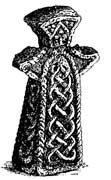Select a site alphabetically from the choices shown in the box below. Alternatively, browse sculptural examples using the Forward/Back buttons.
Chapters for this volume, along with copies of original in-text images, are available here.
Object type: Upper arm of cross-head [1]
Measurements: H. 20 > 18 cm (7.8 > 7 in); W. 20 cm (7.8 in); D. 12 > 10.5 cm (4.7 > 3.9 in)
Stone type: Pale red (10R 6/2), medium- to coarse-grained (0.3 to 1.0 mm, but mostly in the range 0.4 to 0.6 mm), angular to sub-angular sub-angular, clast-supported, friable quartz sandstone; a few flakes of mica. ?Sherwood Sandstone Group, Triassic (see pp. 13–14). A second piece from this box was similar to the above, but ranged up to very coarse-grained (1.5 mm).
Plate numbers in printed volume: Ills. 139-40, 144-7
Corpus volume reference: Vol 9 p. 77
(There may be more views or larger images available for this item. Click on the thumbnail image to view.)
Both broad faces are bordered by roll mouldings.
A (broad): A simple pattern E knot forming a triquetra.
B (narrow) and E (top): No decoration
C (broad): This appears to be divided into sub-panels by an inverted V-shaped moulding, with a vertical bar beneath. Pellets are set above the inverted V and flank the bar.
D (narrow): Damaged
This fragment has long been reconstructed as part of the shaft Disley (Lyme Hall) 2, but geologically seems to differ (see Chapter III, pp. 13–14). The triquetra in the head is a common motif. Less common is the arrangement of groups of small pellets divided into panels, but such combinations do occur elsewhere in Viking-age sculpture (see discussion under Chester St John 5, pp. 66–7).



